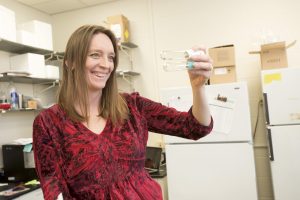
An old nursery rhyme called Siphonaptera was way ahead of its time:
Big fleas have little fleas,
Upon their backs to bite ‘em,
And little fleas have lesser fleas,
And so, ad infinitum.
Not to say that human beings are flea-ridden, but we — and all complex (that is to say, multicellular) organisms — are really communes of cells, most of them microbes. (See North Forty News, March 2011) Microbial cells outnumber human cells by 10 to one in our bodies. More importantly, 400 microbial genes busily churn out various biologically active compounds for every human gene engaged in that enterprise. It’s no wonder that researchers like Colorado State University Prof. Tiffany Weir are beginning to concentrate research efforts on our “microbiomes” to figure out how to maintain health and happiness in consort with all our diminutive partners.
The North American branch of the International Life Sciences institute recently honored Weir with the 2014 Future Leader Award, which includes a $30,000 prize she will apply toward her research goals. Weir seeks to discover why people often respond quite differently to the same diet, making the control of cholesterol, for example — which is a heart disease risk factor — difficult for many people. “The intestinal microbiota,” Weir said, “are important in regulating digestion, the immune system, and disease development and I want to take some of our existing data and look at it in a different way.”
Much of that existing data came from a diet intervention trial that recruited 40 colon-cancer survivors to see if diet could change the mix of microbes in their digestive tracts and reduce intestinal inflammation. In some cases the diet, which included dry beans and rice bran, did shift the microbiota. The microbes in other patients held their ground and resisted change. But this study provided Weir and her colleagues with information about fat (lipid) parameters for each patient and with blood samples that can now be screened for specific genetic mutations that might contribute to different individual responses to diet. “Hopefully,” said Weir, “the data that we get from this analysis will provide sufficient evidence and direction to seek funding to conduct a large scale study specifically tailored to the questions we want to answer.”
Researchers often find motivation for their work from their personal lives. Such was the case for Weir whose father has high cholesterol that didn’t respond well to suggested diets. The fruits of her research may or may not ripen in time to help her own family. Getting from research to clinical recommendations from a doctor depends on many factors—including how up-to-date doctors are with the research in health and nutrition, and how convincing a given researcher is in designing a study that everyone agrees has merit. It also depends on how well the researcher communicates with the general public.
Weir said, “I’d say that there usually needs to be at least a couple of well-designed clinical studies that are in agreement before a physician would recommend something.”
Of course, patience is not a hallmark of modern American culture. Now that personal microbes have become the subject of cocktail conversations, everyone wants to know who possesses “super bowel” contending varieties. Radio personality Rob Stein, for example, offered samples from his microbiome to the American Gut Project. For $99 you can find out how your microbes match up with others. Unfortunately, the state of our ignorance about this field is still so vast that it will take much work by labs like Weir’s before we have enough information to properly understand the inner workings of our personal communes.
And so far, researchers mostly study bacteria, because they have the tools to do so. The Human Microbiome Project, sponsored by the National Institutes of Health, provides information on the current state of the field. There is another microscopic world composed of viruses that dwarf that of bacteria and that science knows even less about. Weir mentions that her lab will concentrate on bacteria rather than viruses (or fungi) because an existing data set is already out there for bacteria that can be used for reference.
As we eat, drink and make merry, we now have to consider the welfare and happiness of the microbe passengers aboard our personal ship of state. Deciding how to do that will become easier now that science knows about our inner universe and continues to reveal precisely how it functions.
Gary Raham is a writer and illustrator based in Wellington. He is author of “The Restless Earth: Fossils, The Dinosaurs’ Last Seashore,” “A singular Prophecy” and other titles of science fact and science fiction.
Support Northern Colorado Journalism
Show your support for North Forty News by helping us produce more content. It's a kind and simple gesture that will help us continue to bring more content to you.
BONUS - Donors get a link in their receipt to sign up for our once-per-week instant text messaging alert. Get your e-copy of North Forty News the moment it is released!
Click to Donate

